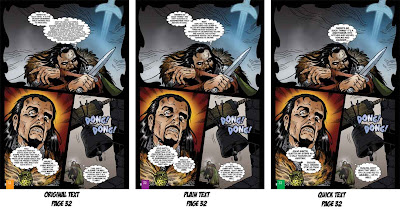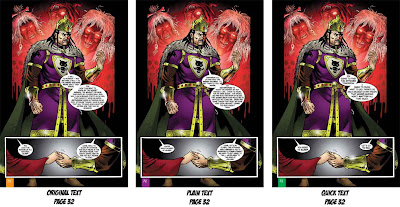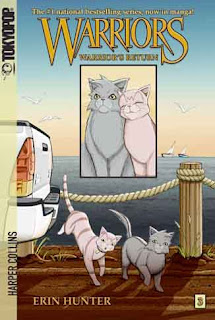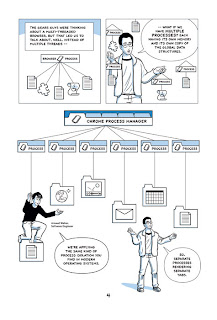
 By Chris WilsonEditor-in-Geek
By Chris WilsonEditor-in-GeekORIGINAL AUTHOR: William Shakespeare
SCRIPT ADAPTATION: John McDonald
ILLUSTRATOR: Jon Haward
COLORS: Nigel Dobbyn
LETTERING: Nigel Dobbyn
PUBLISHER: Classical ComicsGENRE: Traditional Literature in Comic Format
FORMAT: Softcover
EDITIONS: Original Text, Plain Text, and Quick Text
PAGES: 144
COLOR: Full color
ISBN (Original Text): 1-906332-03-7
ISBN (Plain Text): 978-1-906332-04-4
ISBN (Quick Text): 978-1-906332-05-1
REVIEWSometimes you have those moments, the ones when you look at a product and wonder why you did not think of it first. Such a moment happened to me when I picked up my first copies of Classical Comics’ MACBETH. This three-volume set was jaw dropping in its ingenuity, approach to comic literature, and classroom utility.
Classical Comics kneaded the word “adaptation” in such a common sense way, I am befuddled that no one thought of it before. Other comic adaptations of classic literature make a choice: Replicate every word and every scene exactly as it was in the original text, or take liberties with the language and the storyline. Classical Comics, on the other hand, takes what should be the obvious choice - all of the above - and creates different versions of the story to suit both traditional purists and modern audiences. The result is a brilliant product in three volumes, perfect to suit the needs of many, while still maintaining the authenticity of the original text. It is brilliant.
MACBETH: Original TextThis volume takes every scene, every word of Shakespeare’s classic play and adapts it into a comic. It is the full, unabridged play with original language intact.
MACBETH: Plain TextThe Plain Text volume uses the same art as the Original Text volume. The entire play is reproduced; however, the language is translated into Plain English,
MACBETH: Quick TextThe third adaptation also uses the same art as the first two. The story is still the same; however, this volume takes the Plain Text language and culls all words that are unnecessary to the essence of the story. What is left is an easy-to-read translation for struggling readers.
The illustrations are also very appealing as they are detailed, colorful, and representative of modern comics. The art does not play to the child, but caters to a wide audience, pulling no punches and showcasing the story conscientiously.
Taken together the triad provides an unprecedented initiation into the world of Shakespeare, one that allows for young and old, strong reader and struggling reader, boy and girl, Shakespearean scholar and neophyte.


AGE RECOMMENDATIONMy Rating: Ages 10 and older (Quick Text)
My Rating: Ages 12 and older (Plain Text)
My Rating: Ages 15 and older (Original Text)
Publisher’s Rating: Grades 5 and up (Quick Text)
The publisher suggests using the Quick Text version starting with fifth graders and making use of the other editions for older students.
BE AWAREShakespeare is full of greed, hate, jealously, sex, alcohol, murder and more. His works are about life. Fortunately, Shakespeare is considered “classic” and therefore such issues, which might be troublesome for other comics, may be more acceptable even with younger students.
IN THE CLASSROOMShakespeare was meant to be seen, not read. The comic adaptation is the perfect venue for the literature class as it melds the visual aspects of the play with the beauty of the written language, making the story come to life. With the different versions, a teacher is now able to plan for different reading levels of students and find the best edition for each student or class.
A teacher could make use of all three editions in one classroom of diverse readers, each student receiving a comic based on his or her ability level. If that proves problematic or troublesome, then a teacher could assign the Plain Text version for all, but refer back the Quick Text and Original Text daily, comparing and contrasting the different versions and using the modern translations in order to decipher the original.
OTHER INFORMATIONOther tittles available or in the works include:
THE CANTERVILLE GHOST
A CHRISTMAS CAROL
DRACULA
FRANKENSTEIN
GREAT EXPECTATIONS
HAMLET
HENRY V
JANE EYRE
RICHARD III
ROMEO & JULIET
THE TEMPEST
WUTHERING HEIGHTS
Previews of the books are available by
clicking here.
Classical Comics is currently developing a comprehensive package of tools and resources for educators. They also offer vignettes from other works for free download.
MY RECOMMENDATION:Highly RecommendedShakespeare has never been so accessible, so meaningful or approachable to the modern masses as it is in the Classical Comics’ adaptations. The different editions are elegant and beautiful - a true homage to The Bard. These are, simply put, the best comic adaptations of Shakespeare I have ever encountered.



























